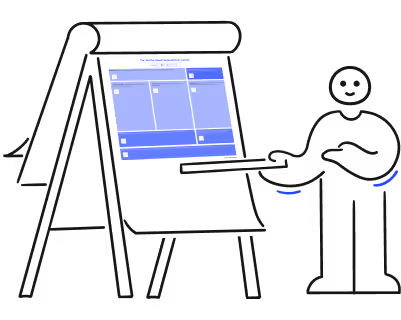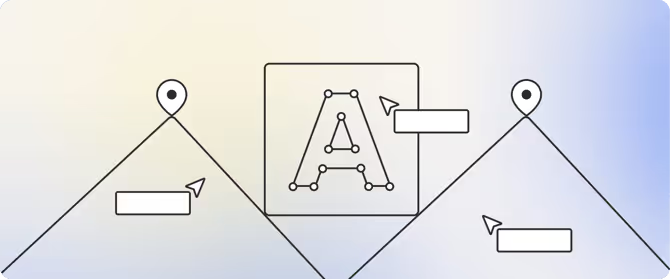Democratizing skills mapping for organizational success

Empower your organization with the skills-based canvas.

The workplace is undergoing a transformative evolution. Facing a surge in resignations 40% higher than in pre-pandemic times, the need to keep up with rapidly emerging technology, a volatile market, and the integration of a new generation of workers (to name a few) — the stakes are high for HR professionals.
These changes have intensified the pressure to retain top talent and maintain operational efficiency amidst the turbulence. In response, a strategic shift is unfolding within HR circles, where the spotlight is increasingly focusing on talent development, with skills mapping emerging as a critical tool.
Skills mapping: A must-have approach to talent management and development
Skills mapping is pivotal to understanding and enhancing employee capabilities and making sure that entire organizations, team by team, are equipped for both present and future needs. If leadership has a murky view of employees’ skills and competencies, how can they make accurate and strategic decisions for organizational growth?
{highlight}For instance, consider a technology firm that realized its project teams were consistently missing deadlines. An in-depth skills analysis revealed a gap in advanced project management and Agile methodologies among team leads. By gaining clear visibility into these specific skill deficiencies, the HR department was able to implement targeted training programs. As a result, the firm saw a 30% improvement in project delivery timelines within six months, underscoring the strategic advantage of having a transparent view of employee competencies.{highlight}
This kind of skills visibility empowers HR professionals to make well-informed decisions, accurately identify skill gaps, and create targeted development plans.
While there is no perfect formula for organizational success, leaders across 40 countries can agree—the top HR priorities for 2024 must be operational effectiveness, career and change management, and investing in the right technology. And at the heart of fulfilling these priorities lies the powerful solution of skills mapping.
{emphasize}SKILLS MAPPING 101
What
Skills mapping is a strategic process used in human resource management to assess, identify, and record the skills and competencies of employees within an organization. It involves creating a detailed inventory of your employees' skills, including technical abilities and soft skills.
How
This process typically includes evaluating individual employee skills through various methods such as performance reviews, aptitude tests, or self-assessments. The gathered information is then organized and visualized, often as a map or skills matrix, allowing HR, leadership, and managers to identify gaps in competencies and areas for improvement quickly.
Why
Skills mapping can be used to measure both technical and soft skills. It plays a pivotal role in organizational success by making sure that your workforce is well-equipped with the necessary skills to meet current and future challenges, driving growth and innovation.{emphasize}
Benefits of skills mapping
Skills mapping is critical in many strategic aspects within an organization. Leadership and managers use these maps to make informed workforce planning decisions—from succession planning to forming the right teams for specific projects. Skill maps can also pinpoint skill gaps to help make strategic decisions on training and development as part of continuous performance management.
Because skills mapping is a technique that utilizes data and removes bias for making talent-related decisions, benefits include (but aren’t limited to):
- Enhancing performance management objectivity
- Elevating the efficacy of employee training programs
- Refining recruitment processes
- Enabling strategic succession planning
- Fostering an inclusive workplace culture
With 64% of Learning & Development experts advocating for the reskilling of existing teams to address skill gaps the importance of skills mapping in today's HR landscape is clear. It has evolved from a supplementary tool to an indispensable practice for HR professionals dedicated to effectively navigating the intricacies of modern talent development.
Putting the focus on talent development for talent retention
When over 65% of employees report that they would likely stay with their employer if they tried to upskill or reskill them, the link between talent development and retention has never been so strong.
By prioritizing skill-building opportunities and career progression plans, companies can better foster engagement, motivation, and job satisfaction in a way that resonates with the needs of today’s workers.
In an environment where skill requirements are ever-changing, the ability for employees to grow alongside the organization is invaluable.
Talent development is pivotal for the long-term success of a business, ensuring a skilled workforce ready to meet future challenges. Skills mapping serves as the strategic foundation for this ongoing talent development, directly contributing to employee retention and organizational resilience.
Making skills mapping more accessible: 6 essential steps
In our journey towards democratizing skills mapping, it's essential to have a clear, structured approach. This 6-step framework is designed to make skills mapping more accessible, inclusive, and effective at your organization.
- Define clear objectives and skills needs
Begin by establishing the purpose of your skills mapping initiative. Objectives could range from talent development to recruitment.
Example: Say your company aims to identify potential leaders for succession planning. The required skills include leadership, strategic thinking, and industry-specific knowledge. - Focus and establish guidelines
Narrow down to specific skills and roles needed to achieve your objectives. Set guidelines for assessment methods, ensuring they are inclusive and consider diverse learning and working styles.
Example: For leadership roles, include assessments that measure strategic thinking and emotional intelligence, not just technical skills. - Implement skills assessments
Conduct assessments using the established methods, making sure that they are accessible to all employees. This means taking into consideration factors like:
Technical accessibility
Does everyone have the right user access if conducted online? Does the evaluator have complete visibility of all data needed?
Location
Is your workforce in-office, hybrid, or remote? Will equal options be available to all, no matter where they work?
Language
Are instructions and tests made available in a language the employee understands easily?
Example: Use a combination of self-assessments and performance data to evaluate potential leadership skills. - Gather comprehensive feedback
Collect feedback from peers, managers, and other relevant stakeholders to get a holistic view of each individual's skills and potential.
Example: Implement a 360-degree feedback process focusing on leadership potential and team collaboration. - Analyze results and map skills
Analyze the collected data to identify skills profiles, strength, weaknesses, and development opportunities.
Examle: Use the analysis to create a talent pool for leadership development, identifying current strengths and growth areas. - Make informed and inclusive decisions
Now armed with a clear map showing skills available and gaps, you can make informed decisions that are aligned with organizational goals and promote a culture of learning and development.
Example: Develop personalized training programs for employees in the talent pool, focusing on enhancing their leadership skills.
Implementing skills mapping strategies with Workleap Skills
While skill mapping like this at the organizational level is essential, it can typically take months of manual work. It then also runs the risk of being outdated the minute it is completed due to constant changes in the makeup of your workforce. Oouf! This is where AI and skill mapping tools like Workleap Skills come in and make it possible for HR leaders and managers to now map their entire organization’s skills in a matter of minutes.
A tool like Workleap Skills makes it all the more accessible by automating these steps, making talent development a dynamic and shared mission.
Beyond just a tool, Skills encourages active employee participation and ownership in the skills mapping process through its user-friendly, intuitive features, like:
- Drag-and-drop skills assessment
In just a few clicks, your employees will get a clear view of their skills, rated by their level of expertise for each.
- AI and peer benchmarking
Workleap uses AI to explain different levels of expertise for each skill in your directory, helping guide employee self-assessment. Employees can also see how coworkers rate themselves, developing self-awareness and sharpening skills mapping accuracy.
- Custom skills and descriptions
Easily customize your skills and their description so that everyone on your team speaks the same language and remains on the same page. It helps make skills assessments strategically aligned with your objectives and culture. - Reports
Get a crystal-clear view of skills from the organizational level to individual teams. From participation reports to skills inventory gaps to advanced workforce segmentation, Workleap gives you full visibility into the DNA of your team so that you can make data-driven decisions.

See the future of skills mapping in action with Workleap
As the workplace continues to evolve, investing in the right tools is an investment in crafting success stories for both individuals and organizations. Skills mapping is the driving force behind talent development, made tangible with Workleap Skills. Addressing the critical need for visibility into people's skills, Skills is a tool that empowers HR professionals with data-driven insights. It’s a solution that emphasizes the importance of continuous improvement and puts humans at the center of investment.
At Workleap, we recognize that shaping the future of work is a shared responsibility. Our software is crafted to demystify skills mapping, making it an accessible, equitable, and transparent process for everyone. And we know that the value of our innovative solution is best experienced firsthand. We invite you to experience this modern approach to skills mapping directly by booking a demo with one of our product specialists today.
Monitor, support, and optimize your team's professional development.


%20(1).avif)


.avif)
.avif)






.avif)

